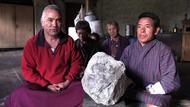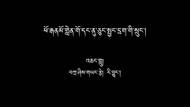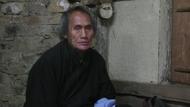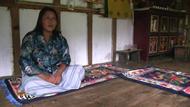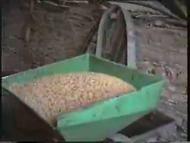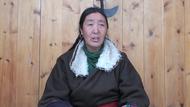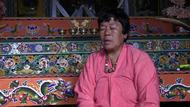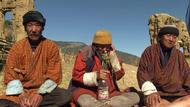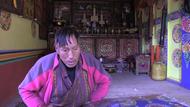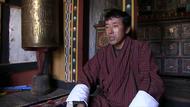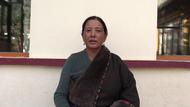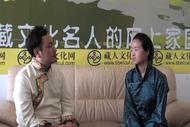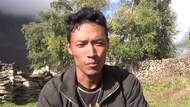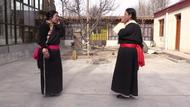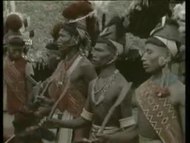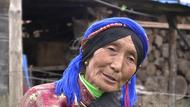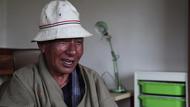Video Overview
Ap Nimchu speaks about the seat of Pha Drung Drung at Jangsarbu Temple. This temple's main sacred objects are its Buddha Shakyamuni statue (brought from Ralung in Tibet), a volume of scripture written in gold, and a stupa that represents the mind of the Buddha. According to tradition, the knee of the statue was damaged at a place called Phari while it was being transported to Paro. The footpath was very narrow, and it was not possible to pass. People thought to cut the statue apart, when suddenly the statue spoke to Namkha Gyeltsen, the son of Pha Drung Drung, saying that they should not do so. Miraculously lightening its weight, the statue sustained that a single person could carry it.
- Jangsarbu
- རིག་འཛིན་སྒྲོལ་མད་ཐུགས་འཚེར་རུང་ ད་ལྷ་ཁང་འདི་གི་སྐོར་ལས་ཅིག་ ག་མཁྱེནམ་ཅིག་ཨ་ཞང་གིས།If you don't mind, can you tell anything that you know about lhakhang, uncle?
- ཉིམ་ཅུང་ཨ་་་་་ད་ཏེ་ བྱང་གསར་བུ་ལྷ་ཁང་གི་གནས་བཤད་མདོར་བསྡུས་ཅིག་ཨིན་མས་སྨོ? ཏེ་རྒྱས་ཤིང་རྒྱསཔ་སྦེ་ ང་གིས་མི་ཤེས།Aaa...you want me to explain briefly about Jangsarbu lhakhang, right? I don't its detail.
- རིག་འཛིན་སྒྲོལ་མཏེ་མ་པ་ཏེ་ ང་ལས་ཁྱོད་ར་ཚུ་གསལ་ཏེ་ ཁྱོད་ར་གཡུས་སྒོའི་ལྷ་ཁང་མས།Infact you all might be knowing clearly than me, as its your village lhakhang.
- ཉིམ་ཅུང་འདི་ནང་རྟེན་ཉིད་ལས་ལྷ་ཁང་གི་སྦྱིན་བདག་མས། ཏེ་ད་ཁྱོད་ལཱ་འདི་ར་ཏེ་ ལྷ་ཁང་ཆ་ཁྱབ་པའི་གི་ནེམ་བཟོ་འདི་(སྟེ་)གིས་འབད་ ཁྱོད་འགོ་འདྲེན་རེ་འཐབ་ འདི་ཨིན་མས་སྨོ་ཤིག ༷A far from that you are the owner of the lhakhang. Your only responsibility is to make documentation about Temples and coordinate it, right?
- ཉིམ་ཅུང་ཏེ་ད་ ན་གི་གནས་བཤད་ཀྱི་ལོ་རྒྱུས་ཅིག་བཤད་ནེམ་འབད་ནི་མས་སྨོ?Now you are going to explain something about this temple, isn't it?
- ཉིམ་ཅུང་ཏེ་ད་མ་པ་ བྱང་གསར་བུ་ལྷ་ཁང་འདི་ ཏེ་རོགས་གནད་བཤད་ནང་ཡང་མཁས་དྲག་ གནམ་མེད་ས་མེད་རྩ་ཆེ་དྲག་ཅིག་སྦེ་རྩེཝ་ཨིན་མས། ཕ་དྲུང་དྲིང་རིན་པོ་ཆེ་གི་གདན་ས་ ཏེ་རྟེན་གྱི་གཙོ་བོ་ཇོ་བོ་ཤཱཀྱ་མུ་ནི་འདི་ ཏེ་རོགས་ཡ་བོད་ར་ལུང་ལས་ ཏེ་གདན་འདྲེན་ཞུ་ཡི་གསེས་ཨིན་མས།Actually, the Jangsarbu temples is reflected as a sacred place in the books of geographical explanation of places. It is a seat of Drungdrung Rinpoche and the sacred object present is also of a Jo Sacha Muni that had been invited from Ralung in Tibet.
- ཉིམ་ཅུང་དེ་ལས་ ཇོ་གི་སྐུ་ཚད་ཡང་ལྷ་ས་ཇོ་བོ་ལས་ཞུ་ སྐུ་གཟུགས་འདི་གསེར་ཟངས་ལས་བསྒྲུབས་ མཚན་འདི་ཤཱཀྱ་མུ་ནི་སྦེ་ཕུལ་ ཇོ་བོ་འདི་ཏེ་གནམ་མེད་ས་མེད་བྱིན་རླབས་ཅན་ཨིན་ ཇོ་བོ་ག་ཅི་འདེ་ཅིག་ ཏེ་བྱིན་རླབས་ཆེ་དྲག་གི་ཇོ་བོ་ཅིག་ཨིན་མས།The size of Jo was also received from Lhasa Jowo, its statue was made out of gold and copper and was named as Shacha Muni. The Jo is very sacred.
- ཉིམ་ཅུང་ཏེ་ཡ་ལས་མ་ཏེ་གདན་འདྲེན་ཞུཝ་ད་ འཕགས་རི་སྤྱན་པའི་ལ་འོག་སྟོད་བྱག་གསེས་མི་ནང་ལྷོདཔ་ད་ ཏེ་ཞུ་མི་ཚུ་གིས་ཐབས་ཤེས་གནས་སྐབས་མ་སྟོན་པ་ གདོང་འཕྲང་ཞུཝ་ད་ཞབས་འདི་ཕར་བྱག་གུ་ཕོག་འདི་(སྟེ་)སྟིམ་དཔ་མས་ ཏེ་ཞབས་བྱག་གུ་ཕོག་སྟིམ་དཔ་ཞིནམ་ལས་ ཁོང་གིས་ཏེ་བླ་མ་ལུ་ཞུ་ ད་ང་བཅས་ཀྱིས་ཇོ་བོ་འདི་ གདན་འདྲེན་ཞུ་མི་ཚུགས་པས་ ཞབས་སྟིམ་ད་ཡི། སྐུ་གཟུགས་འཕྱལ་དགོ་པས་གསེས་བླ་མ་ལུ་ཞུཝ་ད་ དེ་ལས་རོགས་བླ་མ་གིས་ ཏེ་གམ་སྨོ་གསེས་བ་ཅིན་ མཁས་པའི་ནེམ་འབད་ནི་འདི་གིས་ མངོན་ཤེས་མཁྱེན་འདི་ ད་ཇོ་བོ་འདི་གསུང་བྱོན་ནི་མས་མནོ་བའི་ཐུགས་བཞེད་ཅིག་བླ་མ་གིས་གནང་གནངམ་མས།While it was invited down from up and when reached cliff Toed of lower Phanri Chenpi mountain, the people without any idea, received it straight to face and the foot hit on the cliff and was dented. Followed they informed lama that they now cannot invite Jo as its foot dented and had to dismantle its body. As lama was skilled person, had percepted and thought that Jo is going to speak.
- ཉིམ་ཅུང་ཏེ་རོགས་བླ་མ་གིས་ཞལ་ལས་མ་གསུངམ་ཞིནམ་ད་ བོད་སྐད་སྦེ་གསུང་འདི་(སྟེ་) འཚབ་འཚབ་མ་བྱེད་ལྷོད་ལྷོད་འབད་ འདི་ཡི་བཟློག་ཐབས་ཅིག་འོང་གསེས་ བླ་མ་གིས་ཞལ་ལས་འ་ནེམ་ཅིག་གསུངས་ནུགThen lama spoke in Tibetan language that not to be in hurry, do it leisurely as there would be some methods to overcome this problem.
- ཉིམ་ཅུང་ཏེ་བླ་མ་འ་ནི་གསུངས་ ཚོད་ཚོད་ཅིག་ཁ་ལས་ཏེ་ཇོ་བོ་གིས་གསུང་བྱོན་ད་ནུག ༷Immediately after lama said such thing, Jo begun to spoke.
- ཉིམ་ཅུང་ཇོ་བོ་གིས་གསུང་བྱོནམ་ད་ ཕ་དྲུང་དྲུང་གི་སྲས་ནམ་མཁའ་རྒྱལ་མཚན་གསེས་མི་འདི་ལུ་གསུངས་གསུངསམ་མས། ཡ་ནམ་མཁའ་རྒྱལ་མཚན་ ཁྱེད་ང་གཟུགས་འཕྱལ་མི་དགོ་ གཡས་སུ་གསེས་གསུངམ་མསལོ་ ཏེ་གཡས་སུ་གསེས་བའི་བསྒང་ལས་ ཧེ་མ་གདོང་འཕྲང་ཞུ་ཞུཝ་མས་ ཏེ་འ་ནི་ཞབས་སྟིམ་སྟིམ་མས། ཏེ་འ་ནེ་སྦེ་མ་ཐལ་བ་ ཏེ་གཡས་སུ་གསེ་བའི་བསྒང་ལས་ ཏེ་ཟུར་སྒོར་བའི་བསྒང་ལས་ཐལ་བས་བ་སྨོ་ཤིག འ་ནེ་སྦེ་ལེགས་ཤོམ་སྦེ་ཏེ་ གདན་འདྲེན་ཞུ་ཆི་ནུགWhen Jo spoke, the message was to the Namkha Gyaltshen a son of Drung Drung. And he said 'oh! Namkha Gyaltshen, you don't have to dismantle my body to right'. Right means that before the face was straight and the foot got dented and right means to roll from side and was invited nicely.
- ཉིམ་ཅུང་ཏེ་ཡ་ལས་ཞུ་ ན་གི་ས་སྒོ་ལུ་ལྷོདཔ་ད་ཏེ་ རོགས་ན་གི་སྦྱིན་བདག་ཁྱལཔ་དགུ་པོ་གིས་ བླ་མ་ལུ་ཞུ་ ད་ཇོ་བོ་འདི་ཡ་རྫོང་ན་མ་ཞུཝ་ལས་ང་བཅས་ཀྱིས་གསོལ་ཇ་ཅིག་དྲང་ནི་གསེས་ ཏེ་དེ་ལས་ཏེ་བླ་མ་གིས་ རྟེན་འབྲེལ་ལེགས་ཤོམ་མས། དེ་འབད་བ་ཅིན་བཏུབ་བཏུབ་གསེས་ ཏེ་ཇོ་ནི་རྡོའི་ཁྲི་ཅིག་བརྩིགས་སྦེ་ ཏེ་འ་ནི་གུ་བཞུགས་བཅུག་ ཏེ་གསོལ་ཇ་དྲངས་འདུགAfter invited from up and when reached here, the nine tax payer patrons requested lama that before taking Jo to the dzong, they would like to offer a tea and lama said its a good ceremony and accepted the offer. While the tea was offered, a Jo was rested on the piled stone throne.
- ཉིམ་ཅུང་ཏེ་གསོལ་ཇ་གྲོལ་སྦེ་འབད་ ཏེ་རྫོང་ནང་ལུ་གདན་འདྲེན་ཞུ་ནི་འབདཝ་ད་ ད་རུང་གསུང་བྱོན་ནུག་ལགས། ཡ་ང་རྫོང་ནང་མེན་ ངེའི་གདན་ས་འདི་ན་ཨིན་ ང་ན་ལུ་བཏུབ་པས་གསེས་ ཏེ་ནི་ལས་རྫོང་ནང་ལུ་བྱོན་མ་བཏུབ་མས།After done with tea ceremony, was about to take Jo to the dzong, but again Jo spoke saying that its seat is here and its okay here. So Jo denied to go to the dzong.
- ཉིམ་ཅུང་ཏེ་འ་ནི་ ཏེ་རོགས་བླ་མ་གིས་ཐུགས་སྨོན་གནང་ ཏེ་ལྷ་ཁང་ན་བཞེངས་བཞེངསམ་མས། ཏེ་སྐུ་འདི་ཇོ་བོ་ཁོ་ར་ཞུ་འདུག་ ཇོ་ཤཱཀྱ་མུ་ནི་ གསུང་འདི་གསེར་གྱི་བརྒྱད་སྟོངམ་འདི་ ཏེ་ཐུགས་འདི་ཐུགས་གཏད་མཆོད་རྟེན་ ཏེ་ནི་ལས་དཀར་མེ་ཁོ་གཡོ་ དཀར་མེ་ཁོ་གཡོ་འདི་ཏེ་ང་བཅས་ར་རྫོང་ཁག་ཁལ་གཅིག་གི་ལྷ་ཁང་དགོན་སྡེ་ག་དེམ་ཅིག་ཡོད་རུང་ འདི་ལས་སྦོམ་ཡང་འོང་ ཆུངམཡང་འོང་ ཏེ་ན་གི་འདི་གནམ་མེད་ས་མེད་མནང་བ་ཆེ་དྲག་ བྱིན་རླབས་ཆེ་དྲག་ འ་ནི་ཏེ་བོད་ཀྱིས་ ཏེ་རོགས་གནམ་མེད་ས་མེད་ཅ་ལ་གནང་ཅན་ ཟངས་ཆུ་ར་གསེས་ཟང་ལོ་གསེས་མི་འདི་ཏེ་ ནོརཔ་བཟུམ་ཅིག་མས་ ཁོ་ར་གིས་འདི་འ་ནེ་སྦེ་གདན་འདྲེན་ཞུ་ནུགThen lama prayed and was placed inside the temple. The body was Jo himself, the Jo Shacha Muni, speech was golden Gaytongm and the mind was a Thuktoed Choeten. No matter how many temples and monastries are there within twenty dzongkhag, there would be bigger as well as smaller than it but the butter-lamp which is here is very much sacred and for Tibet the copper is like a gem and was made of it.
- ཉིམ་ཅུང་ཏེ་ད་ན་ཁྱེད་ར་ཤེས་ས་ཨིན། བྱང་གསར་བུ་ལྷ་ཁང་ན་ལུ་ཏེ་ ཇོ་བོ་འདི་གིས་གཅིག་ ཁོ་གཡོ་འདི་གིས་གཉིས་ གསེར་གྱི་བརྒྱད་སྟོངམ་གསུམ་ ཏེ་མནང་ཆེ་ཤོས་རང་འ་ནི་གསུམ་པོ་ཨིན། ད་ཏེ་འ་ནི་གསུམ་པོ་བྱིན་རླབས་ཆེ་ནི་འདི་གིས་ ག་ཏེ་གི་མི་གིས་ཡང་མཇལ་བ་ལྷོད་པས། ཚར་གཅིག་བལྟ་ཤིགNow its clear to you that here in Jangsarbu temple, the three most sacred objects are firstly Jo, followed by Kho-yo and the golden Gaytongm. As this three are very much sacred people from every where come here to pay a visit. You just have a look.
- ཉིམ་ཅུང་དེ་ལས་ཏེ་ ལྷ་ཁང་གི་ལོ་ལས་བཅད་པ་ཅིན་ ད་ལོ་དྲུག་བརྒྱ་ལྷགཔ་ཨིན་གསེས་ཨིན་མས། དུས་རབས་བཅུ་བཞི་ལུ་ཇོ་བོ་གདན་འདྲེན་ཞུ་ཞུཝ་ཨིན་གསེས་མས་བ་ ཏེ་འ་ནེམ་ཅིག་ཁ་ཏེ་ ཇོ་བོ་གདན་འདྲེན་ཞུ་སྦེ་ལྷ་ཁང་བཞེངས་བཞེངསམ་མས། ཏེ་ང་བཅས་ཀྱིས་ཏེ་ ཨིན་སྐད་མི་ཤེས་པས་བ་ རོགས་ཨིན་སྐད་ཤེས་མི་གིས་བློ་སླབ་ནི་འདུག་བ་ དུས་རབས་བཅུ་བཞི་ལུ་གདན་འདྲེན་ཞུཝ་ད་ ལོ་དྲུག་བརྒྱ་ལྷབ་ཨིན་གསེས།The temple is approximately more than six-hundred years and it is said that Jo was placed here in 14th century and after that temple was built. We don't understand english and those who knows says that as Jo was placed in 14th century, it equals six hundred years.
- ཉིམ་ཅུང་འ་ནེ་སྦེ་ཨིན་པས། ཏེ་ལྷ་ཁང་བཞེངས་ དེ་ལས་ཏེ་འ་ན་ལས་ཕར་ཏེ་ མགོན་ཀང་(ཁང་)མགོནམ་ཡེས་ཤེས་མགོནམ་གི་མགོན་ཀང་(ཁང་) མགོནམ་གཉིསཔ་མས་ དེ་ལས་མགོནམ་གཉིས་པའི་གི་རྟེན་མདོས་གཏང་དགོ མགོནམ་གཉིས་པའི་གི་གཏོར་རྒྱབ་རྐྱབ་དགོ འ་ནི་ཏེ་བླ་མའི་གི་བཀའ་སྲུང་ཨིན་མས་ཏེ་ བླ་མའི་བཀའ་སྲུང་ ཕ་དྲུང་དྲུང་རེན་པོ་ཆེ་གི་བཀའ་སྲུང་།Its like that. Thereafter, when the construction of the temple was over, have to perform thread-cross exorcism ritual for second chapel's statue out of two inner chapel of guardian deity Yeshey Goenpo, had to perform offerings of pyramidal shape painted in red and white(Torma) and this is the protector of lama's order, Pha Drung Drung's order.
- ཉིམ་ཅུང་ཏེ་ལྷ་ཁང་རྩ་ཆེ་མི་ནི་འ་ནེམ་ཅིག་ཨིན། ཏེ་འདི་ལས་ནང་རྟེན་ཉིད་ལས་བཀའ་འགྱུར་ ག་ནི་ལས་བྱིན་རླབས་ཆེ་བ་ལུ་ ཏེ་སྐུ་རྟེན་གསུང་རྟེན་འདི་ང་བཅས་ར་བྱང་གསར་བུ་ལྷ་ཁང་ནང་ལུ་ཏེ་ ད་རོགས་མི་རྣམས་ཀུན་གྱིས་ཡང་མ་ཤེསཔ་མེད་ ང་བཅས་ར་ཧཱུཾ་རལཔ་(རལ་)རྒེད་འོག་འདི་ནང་ལུ་གནམ་མེད་ས་མེད་ལྷ་ཁང་འདི་ཏེ་བྱིན་རླབས་ཅན་ ཏེ་ན་ཏེ་ཉམས་གསོ་ཅིག་ཞུ་མ་ཚུགས་པ་ཨ་ཙི་ཅིག་ཏེ་ སྟབས་མ་བདེཝ་འ་ནི་ཡོདཔ་ཨིན།This are the reasons for a temple being sacred. Among the sacred inner objects, the very powerful Buddhist canon is the one. Its known by everyone that here in our Hungrel gewong, the sacred objects of Jangsarbu temple is considered as most sacred but the only problem is about its rennovation.
- ཉིམ་ཅུང་ལྷ་ཁང་འདི་ནང་ ག་ནི་རྟེན་བཟང་ སྐུ་རྟེན་གསུང་རྟེན་ག་ནི་བྱིན་རླབས་ཆེ་དྲག་ ཏེ་ལྷ་ཁང་འདི་ག་ར་མེདཔ་འགྱོ་སྦེ་འབད་ ཏེ་འ་ནི་ད་ལྟོ་གཞུང་ལས་ཞབས་ཏོག་ཞུ་ནི་གི་གནང་བ་ཅིག་མ་ཐོབ་པར་ རོགས་རྒ་པ་གིས་(རྒཔོ་གིས་)འགོ་འདྲེན་འཐབ་སྟེ་འབད་དོ་བ་གིས་ཏེ་ ད་ལྟོ་དུང་ཁ་ཨའོ་ཅིག་འགྱོ་མ་བཏུབ་པར་སྡོད་སྦེ་ ཞབས་ཏོག་ཅིག་ལེགས་ཤོམ་སྦེ་ཞུ་ ཉམས་གསོ་ཅིག་ལེགས་ཤོམ་སྦེ་ཞུ་ད་པ་ཅིན་ཏེ་ ཧཱུཾ་རལ་རྒེད་འོག་འདི་ཏེ་ བསྐལཔ་ཆགསཔ་གསེས་རུང་ནེ་ཅིག་རང་ཨིན།The sacred objects inside the temple are very good, very sacred and the temple is now all damaged and we are looking forward for government service in its rennovation. It is coordinated by gup but till date the work are not going well and if we get good services and if the temple is rennovated then it will be the fabulous period of time for Hungrel gewog.
- ཉིམ་ཅུང་རྟེན་རྩ་ཆེ་བ་ལུ་ ཆོས་བཀའ་འགྱུར་བརྟན་འགྱུར་ ད་བརྟན་འགྱུར་མེདཔ་ཙམ་ཅིག་མས་ཏེ་ བཀའ་འགྱུར་ གསེར་གྱི་འབུམ་ག་ར་ན་ཆ་ཚང་ཡོད་ ལྷ་ཁང་བྱིན་རླབས་ཅན་ ང་གིས་ད་ཏེ་ གནས་བཤད་ཞུཝ་གསེས་རུང་འ་ནེམ་ཅིག་ཨིན་མས་ལགས།Other than Tenjur there is complete sets of Buddhist canon as well as golden Buddhist scripture containing 100,000 verses. Its all about the explaination of the temple, no more to explain other than this.
- རིག་འཛིན་སྒྲོལ་མལགས་སོ་བཀའ་དྲིན་ཆེ་ཨ་ཞང་། ཨ་ཞང་ཨ་ནི་ཅིག་ཡང་གསུང་ན་ཨ་ཞང་ ད་ན་ད་རེས་འབད་བ་ཅིན་སྨྱུང་གནས་མས་པ་སྨོ་ཨ་ཞང་?Ok....thank you uncle. Would you mind to tell something about fasting ceremony, uncle. Today fasting is not being conducted, right?
- ཉིམ་ཅུང་ཏེ་སྨྱུང་གནས་འདི་ང་བཅས་ར་ལོ་གཅིག་ལུ་ཚར་གཉིས་ཡོདཔ་ཨིན། ཟླཝ་དང་པ་ཆ༼ཚར༽་གཅིག་དང་ཟླཝ་བདུན་པ་ཆ༼ཚར༽་གཅིག ཏེ་ད་རེས་ཟླཝ་བདུན་པའི་སྨྱུང་གནས་སྨོ་ཤིག ཏེ་ད་;ནངས་པ་གནངས་ཚེས་ཟླཝ་བརྒྱད་པའི་ཚེས་བཅུ་བཞི་ལུ་ཡེས་ཤེས་མགོན་པོའི་གསོལ་ཁ་ རྟེན་མདོས་བཏང་དགོ་པ་ལགས་ འ་ནི་ཡེས་ཤེས་མགོན་པོའི་གསོལ་ཁ་མས།Fasting is conducted twice in a year, once in first month and once in seventh month. Today its fasting of the seventh month and next month that is on 14th of eighth month, have to perform Yeshey Goenpo's prayers of thread-cross exorcism ritual.
- ཉིམ་ཅུང་ཏེ་སྐུ་མཆོད་འབུམ་སྡེ་འདི་ཏེ་ ལེ་ཤ་འབད་དགོཔ་འདུག་ དེ་ལས་ཟླཝ་བརྒྱད་པ་ལུ་ཟླཝ་བརྒྱད་པའི་ཚེ་བཅུ་ཡོད། བྱཱ་གསརཔ་འཚོཔ་ད་ ཏེ་ཡ་གསོལ་ཁ་གསརཔ་ཕུལ་ནི་ འདི་ལས་ཟླཝ་བཅུ་པ་ལུ་ ལོ་འབག་ཟླཝ་ནང་ང་བཅས་གཏོར་རྒྱབ་བརྐྱབ་དགོ་པས་ ལོ་འབག་ཡོད་མེད་ན? འ་ནི་ཁ་ཐུག་གཏོར་རྒྱབ་བརྐྱབ་དགོ་པས་ ཡེས་ཤེས་མགོནམ་གིHave lots to perform such as parinirvana and recite Buddhist scripture. There is Tsechu on eighth month and after the hervest of newly planted paddy, have to perform offering ritual, on tenth month, have to perform perform offerings of pyramidal shape painted in red and white(Torma).
- ཉིམ་ཅུང་ཡེས་ཤེས་མགོན་མའི་གསོལ་ཁ་རང་ཚར་གཉིས་འཕུལ་དགོ་སྨོ་ཤིག? རྟེན་མདོས་གཅིག་ གཏོར་རྒྱབ་གཅིག ལོ་གཅིག་ལུ་འ་ནི་མས།Had to perform rituals of Yeshey Goenpo itself twice, thread-cross exorcism ritual and a pyramidal offerings in a year.
- ཉིམ་ཅུང་ཏེ་འདི་ལསན་ང་བཅས་ར་ ཟླཝ་དང་པ་ལུ་སྨྱུང་གནས་ཆ་གཅིག་ དེ་ལས་ཟླཝ་གསུམ་དང་བཞི་པའི་བར་ན་ལུ་ང་བཅས་སྦྱིན་བདག་ཚུ་ག་ར་བཀའ་འགྱུར་ལྷག་ནི་ཡོད་སྨོ་ཤིག? བཀའ་འགྱུར་བྱིན་རླབས་ཆེ་ནི་འདི་གིས།On first month we conducts fasting ritual and on the third and fourth month, all the patrons gather and recite Buddhist canon as it is sacred.
- ཉིམ་ཅུང་སྔོན་མ་འབད་བ་ཅིན་ཏེ་ ང་ན་འོང་པའི་ལོ་ལུ་འབད་བ་ཅིན་ ལོ་གསུམ་ལུ་ཚར་གཅིག་ལྷགཔ་མས། ཏེ་ད་ཡུདཔ་ཅིག་ལས་ཏེ་ སྦྱིན་བདག་ག་ར་ ཏེ་དཀོན་མཆོག་ཐུགས་རྗེ་གིས་ཏེ་ ལེགས་ཤོམ་སྦེ་འགྱོ་ རྒྱལ་ཁབ་ཡར་རྒྱས་འགྱོ་འབད་བའི་བསྒང་ལས་ཏེ་ རེ་རེ་ཞལ་འདེབས་རེ་ཕུལ་མི་འཐོན་འབད་བའི་བསྒང་ལས་ཏེ་ མ་དངུལ་གྱི་ཡང་དུམ་གྲ་ཅིག་ཏེ་ ལེགས་ཤོམ་འགྱོ་འདི་གིས་ ད་ལོ་རེ་ཚར་རེ་ལྷག་མི་འདི་འ་ནི་ཨིན་མས།Before when I came here for the first time, it was conducted once in every three years. Sometimes later due to the blessing of the Triple Gem, all the patron and as there was some contributors, the financial condition was little better and it was conducted once in a year.
- ཉིམ་ཅུང་བཀའ་འགྱུར་འདི་ག་ཅི་བ་བྱིན་རླབས་ཆེ་ ཏེ་བཀའ་འགྱུར་འདི་ལྷག་པའི་བསྒང་ལས་ང་བཅས་ར་ ད་ལྟོ་གནམ་ཉིམ་ཤར་སྡོད་སྡོདཔ་ ད་ལྟོ་གནམ་སྤུབས་ འབྲུག་ལྡིར་ ཏེ་ཆརཔ་རྐྱབ་ནི་ཡོད་བ་ཏེ་ བྱིན་རླབས་འ་ནེམ་ཅིག་ཨིན་མས། གནམ་མེད་ས་མེད་ཏེ་རོགས་རྒྱལ་བ་གོངམ་གི་ནེམ་འབད་ནི་འདི་གིས་ཏེ་ གསུང་རྟེན་འབད་ནི་འདི་གིས་ ཇོ་བོ་ཁོ་ར་གི་ཐུགས་དང་རྫུ་འཕྲུལ་ དཔལ་ཡེས་ཤེས་མགོན་མའི་བཀའ་སྲུང་གིས་ཏེ་ དམ་ཅན་རྒྱ་མཚོའི་བཀའ་སྲུང་ཚུ་གི་ཏེ་ ཐུགས་དང་རྫུ་འཕྲུལ་ལས་བརྟེན་འདི་(ཏེ་)གིས་གནམ་མེད་ས་མེད་ འ་ནེ་སྦེ་ ཏེ་ལེགས་ཤོམ་འབད་དེ་ ང་བཅས་གཡུས་སྒོ་ལུ་ཡང་དགའ་ཏོག་ཏོ་ སྐྱིད་ཏོང་ཏོ་སྦེ་སྡོད་ནི་ཡོད་མི་འདི་ དངམ་ན་ལྷ་ཁང་ནང་གི་ཏེ་ཇོ་བོ་འདི་གི་སྐུ་དྲིན་ཆེཝ་མས། དེ་ལས་ཆོས་ཀྱི་བྱིན་རླབས་ལས་བརྟེན་འདི་(ཏེ་)ཨིན་མས། དེ་ལས་དཔལ་ཡེས་ཤེས་མགོན་པོའི་བཀའ་སྲུང་།Buddhist canon have that much power that when it is being recited, it turns the present sunny day to the cloudy with thunder and it rains. As its a holy scripture of the noble ancestors, because of Jo's mind and manifestation, and due to the minds and manifestations of order protectors of Yeshey Goenpo and Damchen Gyatsho, our village lives in the atmosphere of peace and prosperity. Its all because of the blessing of Jo, blessings of religious texts and protectors of deity Yeshey Goenpo.
- ཉིམ་ཅུང་ཏེ་སྐུ་མཆོད་འབུམ་སྡེ་འབད་དགོཔ་འ་ནེམ་ཅིག་འདུག ང་བཅས་ར་སྦྱིན་བདག་ཆ་ཁྱབ་གིས(ཀྱིས)།This are the rituals that we the patrons have to conduct.
- ཉིམ་ཅུང་ཏེ་གཞན་ད་ ང་གིས་ཞུ་བ་ཞུ་སའི་ས་སྒོ་མིན་འདུག་ཏེ་ ད་ནེ་ཅིག་ལས་ལྷག་འདི་(ཏེ་)མི་ཤེས་པས་ཏེ།I don't have a topic to talk about anymore and I don't have anything more to than this.
- རིག་འཛིན་སྒྲོལ་མཨིན་མས་སྨོ་ཨ་ཞང།Ya...it is uncle.
- ཉིམ་ཅུང་ད་ སྐྱེས་རབས་འདིནི་ང་གིས་ཤེས་མི་ཚུགས་པས་ རྣམ་ཐརན་ང་མ་མཇལ་ རྣམ་ཐར་མཇལ་མཇལཝ་འབད་བ་ཅིན་འདི་ཏེ་ རོགས་རྣམ་ཐར་ནང་ལུ་ རྒྱས་ཤིང་རྒྱསཔ་སྦེ་འོང་སྨོ་ཤིག?I don't know about life stories as I didn't go through hagiography. If only I had went through hagiography, it all given in it in detail.
- རིག་འཛིན་སྒྲོལ་མན་གི་རྣམ་ཐར་མེད་ག་ཨ་ཞང་?Is there no hagiography about it?
- ཉིམ་ཅུང་ང་བཅས་ར་རྣམ་ཐར་ཡོད་གསེ་གོ་ཡི་ མ་མཇལ་བ་ཏེ་ ན་ལྷ་ཁང་ནང་འདི་ཡོདཔ་འོང་ ང་བཅས་རྣམ་ཐར་ཏེ་ཡོད་གསེས་སླབ་ཨིན། མཇལ་རང་མ་མཇལ་བ་ཏེ། ཏེ་རྣམ་ཐར་མཇལ་མཇལཝ་འབད་བ་ཅིན་ཏེ་ ད་རུང་ཁོང་ལུ་གོ་བ་ཁ་གསལ་འབད་ལེགས་ཤོམ་སྦེ་ མ་པ་ང་གིས་ སླབ་མི་འདི་ཏེ་ ད་འཛོལ་བ་འོང་ འཛོལ་བ་མེདཔ་(ཡོདཔ་)གམ་སྨོ་གསེས་བ་ཅིན་ ང་གིས་རྣམ་ཐར་མ་མཇལ་བ་འབད་ནི་འདི་གིས་ ཏེ་འཛོལ་བ་ཡོད་འདི་(དེ་)འབད་རུང་ མི་རྣམས་ཀུན་གྱིས་མཇལ་སྦེ་ ཏེ་ད་ཐུགས་ཀྱི་བཟོད་པ་བཞེས་དགོ་གསེས་ཞུ་ནི་ཨིན་སྨོ་ཤིག?I had heard that there is hagiography about it but didn't read it. It might be here inside the temple. If I had read this, I would be able to precisely explain about it in detail and as I have not seen and read it, there might be mistakes in my explaination but If I am asked ' is there mistakes'. As I had not read it, if there is mistakes I beg for forgiveness.
- རིག་འཛིན་སྒྲོལ་མཨོང་ལགས།Yes....
- ཉིམ་ཅུང་ཏེ་ང་གིས་ཏེ་ཤེས་ ང་གིས་འབད་ཚུགས་ཚུགསཔ་ཅིག་ཞུ་ཞུཝ་མས་བ་ ཏེ་ང་ན་དུང་ཁ་དཀོན་གཉེར་འབད་ནི་འདི་གིས་ ཨིན་ཅི་མེན་ཅི་ཏེ་ དྲི་བ་ཆུང་ཀུ་ཅིག་བཀོད་དགོ་གསེསཝ་ད་ ང་གིས་ཏེ་ ད་ལྟོ་ཤེས་མི་འདི་སླབ་མི་སེམས་ཁར་བཞག་སྟེ་གིས་ཏེ་ འ་ནི་གིས་དུམ་དྲ་ཅིག་འབད་དགོཔ་ཡར་སོངཔ་མས། ཏེ་གཞན་ ང་གོ་བ་ཁ་གསལ་སྦེ་ ཚུལ་དང་ལྡན་ཏོག་ཏོ་སྦེ་ ཞུ་རང་མི་ཤེས་པས།I know that I had explain as much as I can and as I am the caretaker of this temple, I was by any means asked a short questioned. I had shared all that I could recollect and that I know. I am unable to explain about it orderly.
- ཉིམ་ཅུང་ཏེ་འཛོལ་བ་ཡོད་པ་ཅིན་ཏེ་ ག་ར་ཨིན་རུང་ཏེ་ ཐུགས་ཀྱི་བཟོད་པ་བཞེས་དགོ་གསེས་ཞུ་ནི་ཨིན།If I had said anything wrong, please forgive me.
- རིག་འཛིན་སྒྲོལ་མལགས་སོ། ཨ་ཞང་ཨ་ནི་གྲུབ་ཆུ་གི་ལོ་རྒྱུས་ཅིག་མི་མཁྱེན་ག་ཨ་ཞང་?Ok...Uncle do you know anything about this holy water.
- ཉིམ་ཅུང་ཨོང་མ་པ་གྲུབ་ཆུ་འདི་ཏེ་རོགས་ ཅི་དང་མ་འདྲཝ་ཅིག་ཨིན་མས། ལྷ་ཁང་བཞེངས་ ཏེ་ཇོ་བོ་གདན་ས་ཕུལ་སྦེ་ཞིནམ་ད་ ཏེ་འོག་ལས་ ད་འདི་མ་པ་ཏེ་ ག་གིས་འ་ནེ་སྦེ་ར་སླབ་ནི་འདུག མཚོ་ཅིག་ཆགས་ཆགསཔ་ཨིན་གསེས་ཨིན་མས། ཏེ་ཧེ་མ་འབད་བ་ཅིན་ མཇལ་ཁ་ཡོདཔ་མས་བ་ ཏེ་ང་བཅས་ར་མི་གིས་གབ་ཆ་མཇལཝ་ད་བཙོག་པ་ཞུགས་ ཏེ་མི་ལ་ལུ་སྒྲིབ་ཡོད་མི་འདུག་མེན་ན? འ་ནེ་སྦེ་འབདཝ་ད་ཏེ་ བཙོག་པ་ཞུགས་མི་བཏུབ་པས་གསེས་ ཏེ་རོགས་བཱན་(བཀག)རྐྱབ་རྐྱབ་མས་བར་སྐབས་ཅིག་ཁ་ལས་ ཏེ་འ་ནི་བཱན་(བཀག་)རྐྱབ་ད་ཏེ་ རོགས་ན་ལུ་བླ་མཚོ་མེད་པ་ཅིན་ མ་འོག་ལས་ཆུ་མི་འཐོན་བ་ཏེ་སྨོ་ཤིག?Yes...infact a holy water is extraordinary. actually everyone says that after the temple was constructed and was made a seat for Jo, there formed a lake. Before it was available for visitor and as it was regularly visited by the people, it was contaminated. Some people do have defilements, thats why to not to contaminate recently people were restricted to visit a lake. If there is no lake(lhatsho- a lake where gods and nagas live), water will not come out from down, right?
- རིག་འཛིན་སྒྲོལ་མཨིན་པས།Yes it is..
- ཉིམ་ཅུང་འགོ་སྐམ་པའི་བསྒང་ལས་ ཏེ་ཇོ་ལོ་བྱིན་རླབས་ཆེ་ནི་འདི་གིས་ཏེ་ འོག་ལས་ཏེ་བལྟ་ཤིག? གནམ་དགུན་འབད་བ་ཅིན་ ཆུ་འདི་དྲོད་མོ་སྦེ་སྡོད་ དྲོག་པ་ཧང་ལས་འགྱོ་བ་ཅིན་ཏེ་ཆུ་འདི་དྲོ་ཡོད་བ་ཏེ་སྨོ? འ་ནི་སྦེ་སྡོད་འོང་ ཏེ་གནམ་བྱཱར་འབད་བ་ཅིན་བསིལ་ཏོང་ཏོ་ ད་འ་ནི་ང་བཅས་ར་ཏེ་ མགུ་ན་རུང་ གཟུགས་ཚ་ཚ་ཚིགས་ཚིགས་ན་རུང་ ཚ་ཁྲིམས་བཏབ་རུང་མ་འགྱོ་ འཕྲང་འཕྲང་ར་ཏེ་རང་གྲུབ་ཆུ་འདི་གིས་གཟུགས་འཁྱུ་འབད་བ་ཅིན་ ཧིང་སངས་ས་སྦེ་ བྱིན་རླབས་ཆེ་ཧིང་འ་ནེམ་ཅིག་མས་གྲུབ་ཆུ་འདི་ གནམ་མེད་ས་མེད་རྩ་ཆེ་དྲག་ ཏེ་ད་འ་ནི་འདི་བདག་འཛིན་ལེགས་ཤོམ་སྦེ་འབད་ ནེམ་སྦེ་ཡོད་བ་ཏེ། ཏེ་རོགས་ཟླཝ་ ང་བཅས་ཀྱི་ཟླཝ་གཉིས་པའི་གི་སྤ་རོ་ཚེས་བཅུ་ཁ་ཐུག་ལུ་ཏེ་རོགས་ ཡ་རྫོང་ཁག་ལས་མ་མཚོ་སྨནམ་ལུ་གསོལ་ཁ་ཕུལ་ནིའི་ཕོགས་ཅིག་ཡོད་སྦོ་ ཏེ་འ་ནི་རོགས་མ་ཨམ་ཚེ་རིང་དབངམོ་གིས་འགོ་འདྲེན་འཐབ་སྟེ་གིས་སྦེ་ ཏེ་ལོ་ནམ་ཆད་རང་གསོལ་ཁ་ཁོང་གིས་ཕུལ་དོ་བ།Due to the blessing of Jo, the water is warm during winter and morning, and during summer it remain cold. It is powerful that it can cure all the diseases such as headache, body pain, joints pain and cough and cold by taking bath in it. Therefore it is conserved properly and during the Paro tsechu on second month, there is a tradition of making offerings to a mermaid on behalf of dzongkhag. Aum Tshering Wangmo coordinates and every year they do offerings.
- ཉིམ་ཅུང་ཏེ་འ་ནི་འབད་ནི་འདི་གིས་ ཏེ་རོགས་མ་མཚོ་སྨན་འདི་ཡང་ཉམས་ཆག་ག་ནི་ཡང་མེད་ གྲུབ་ཆུ་འདི་ཡང་རོགས་ དགུན་ཨིན་གསེས་ཆུང་ནི་མེད་ བྱཱར་ཨིན་གསེས་སྦོམ་ནི་མེད་ རྒྱུན་ཆད་མེདཔ་གཟར་ཁའི་ཆུ་གསེས་མི་འདི་འ་ནེ་སྦེ་ ཧེ་མ་ལས་རོགས་ ཇོ་བོ་ཁོ་ར་གི་བྱིན་རླབས་ལས་བརྟེན་འདི་གིས་འབད་ ཏེ་འ་ནི་ཏེ་རོགས་ན་ལྷ་ཁང་མཇལ་བ་འོང་མི་འདི་ཚུ་ ད་གྲུབ་ཆུ་ཅིག་ཡོད་གསེསཝ་མས་ ག་ཏེ་སྨོ་གསེས་དྲིས་འདི་(ཏེ་)གིས་ ཏེ་ང་གིས་སྟོན་ འ་ན་མར་སོང་ འ་ན་མར་ཨིན་གསེས་ ཏེ་ལ་ལོ་ཏེ་ཧོད་འབག་ ཏེ་བཟེད་འབག་ ལ་ལོ་གིས་ཏེ་མར་མགུ་འཁྱུ་ འ་ནི་སྦེ་འགྱོ་མི་ཡོད། ལེགས་ཤོམ་སྦེ་ལགས་ ག་ཅི་བ་སེམས་དགའཝ་སྦེ་ཡོད།There is neither a decline to mermaid nor there is any variation in the level of a lake such as becoming small in winter or big in summer. It fall continuously due to the blessing of the Jo. When people asked me about it, I show them the way towards it and some bring the container and take it, some wash their heads. It very beautiful.
- རིག་འཛིན་སྒྲོལ་མལགས་སོ། །Ok
- ཉིམ་ཅུང་རྩ་ཆེ་དྲག་ཨ་ནེམ་ཅིག་ཨིན། ཏེ་ང་གིས་ཞུ་ནི་གསེསཝ་འ་ནེམ་ཅིག་ལས་ རྒྱས་ཤིང་རྒྱསཔ་སྦེ་ང་གིས་ཞུ་ནི་མེད།Till this much its important and I don't have anything to explain in detail.
- རིག་འཛིན་སྒྲོལ་མལགས་སོ། །བཀའ་དྲིན་ཆེ་ཨ་ཞང་།Ok.....Thank you!
 Loading ...
Loading ... 




